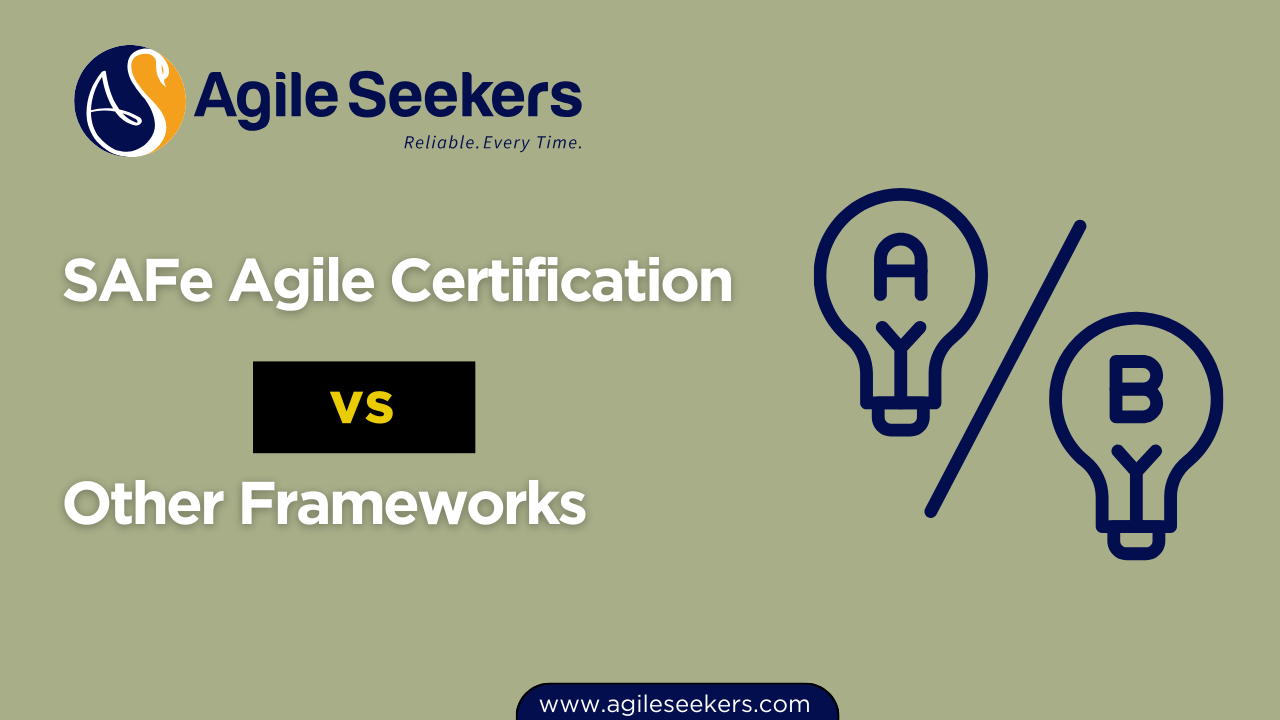SAFe Agile Certification vs Other Agile Frameworks

As Agile continues to shape the future of software development and organizational transformation, professionals often find themselves navigating through various frameworks to identify the most suitable one for their teams or career advancement. Among the prominent frameworks, SAFe (Scaled Agile Framework) has gained immense popularity, especially in large enterprises. But how does it stack up against other Agile frameworks like Scrum, Kanban, and LeSS? This article offers a detailed comparison of SAFe Agile Certification vs Other Agile Frameworks, helping you understand where SAFe fits in the broader Agile ecosystem.
Understanding SAFe: A Brief Overview
SAFe (Scaled Agile Framework) is a comprehensive framework designed to scale Agile across large organizations. It integrates principles from Agile, Lean, and DevOps to align teams and deliver value more efficiently. The SAFe Agile Certification is geared towards professionals who want to lead Agile transformations at the enterprise level. The certification, especially the SAFe Agilist Certification, prepares individuals to adopt Lean-Agile principles and implement SAFe practices across portfolios and teams.
Scrum: The Foundation of Agile
Scrum is perhaps the most widely used Agile framework. It emphasizes small, cross-functional teams working in time-boxed iterations known as sprints. Scrum is simple to understand but requires discipline to implement effectively.
Key Differences from SAFe:
- Scope: Scrum is primarily focused on team-level agility, while SAFe is built for scaling Agile across multiple teams and departments.
- Roles: Scrum has three main roles—Scrum Master, Product Owner, and Development Team. SAFe introduces additional roles like Release Train Engineer, Product Management, and Solution Architect to coordinate across larger systems.
- Certification Focus: Scrum certifications like CSM (Certified ScrumMaster) and PSM (Professional Scrum Master) are team-centric. In contrast, Leading SAFe Certification targets leaders driving organizational change.
Kanban: Visual Workflow Management
Kanban is a lean methodology focused on visualizing work, limiting work in progress, and improving flow. It doesn't prescribe roles or ceremonies, making it highly adaptable.
Key Differences from SAFe:
- Flexibility: Kanban is less prescriptive and can be applied on top of existing workflows, whereas SAFe has a structured implementation roadmap.
- Metrics: Kanban focuses on cycle time and throughput, while SAFe uses a broader set of metrics including PI (Program Increment) objectives, team velocity, and business value.
- Use Cases: Kanban excels in operational or maintenance work. SAFe is ideal for complex, cross-functional projects needing coordination across multiple Agile teams.
LeSS (Large-Scale Scrum): A Minimalist Scaling Approach
LeSS extends Scrum principles to multiple teams working on a single product. It retains Scrum's simplicity while adding rules for scaling.
Key Differences from SAFe:
- Simplicity vs Structure: LeSS stays closer to Scrum's minimalism. SAFe introduces a structured hierarchy and additional layers like Program and Portfolio to handle complexity.
- Team Autonomy: LeSS emphasizes decentralized decision-making. SAFe supports decentralized execution but includes centralized strategy alignment.
- Adoption: LeSS may be easier to adopt for organizations already proficient in Scrum. SAFe offers more comprehensive guidance for enterprises starting their Agile journey.
XP (Extreme Programming): Engineering-Focused Agile
XP emphasizes engineering practices like test-driven development, continuous integration, and pair programming. It complements Scrum and other frameworks by improving code quality and technical agility.
Comparison with SAFe:
- Engineering Practices: SAFe incorporates many XP practices within its Agile Release Trains (ARTs), though its focus is broader than just engineering.
- Scope: XP is more developer-focused, while SAFe addresses business, architecture, and operations in addition to development.
Disciplined Agile (DA): A Toolkit Approach
Disciplined Agile offers a hybrid, context-sensitive approach to Agile. It draws from Scrum, Kanban, SAFe, and Lean, providing teams with a toolkit to choose their way of working (WoW).
How It Differs from SAFe:
- Customization: DA encourages teams to tailor their process, while SAFe provides a more prescriptive path.
- Governance: SAFe includes governance models suitable for enterprises. DA leaves governance decisions to the organization.
Nexus: Scaling Scrum with Minimal Overhead
Nexus, developed by Scrum.org, is another approach to scaling Scrum. It introduces minimal roles and artifacts to coordinate multiple Scrum teams.
Nexus vs SAFe:
- Complexity: Nexus is simpler and suitable for fewer teams. SAFe can handle hundreds of team members working on integrated solutions.
- Implementation: SAFe requires more organizational change and training, which is supported through structured courses like Leading SAFe Training.
Why Choose SAFe?
For organizations operating at scale, SAFe offers several advantages:
- Comprehensive Guidance: From team-level execution to strategic portfolio management.
- Cross-Team Coordination: Agile Release Trains align multiple teams towards a common goal.
- Lean Budgeting: SAFe introduces Lean Portfolio Management to align investments with business strategy.
- Role Clarity: Defined roles at every level ensure accountability and streamlined communication.
- Certifications for Leaders: The SAFe Agilist Certification is ideal for professionals responsible for enterprise-wide Agile transformation.
Also Chec the SAFe Agilist certification cost
Which Framework is Right for You?
The choice between SAFe and other Agile frameworks depends on your organizational size, goals, and maturity level. Here’s a quick guideline:
| Framework | Best For |
|---|---|
| Scrum | Small to medium teams focusing on iterative development |
| Kanban | Teams handling maintenance, support, or operational tasks |
| LeSS | Organizations looking to scale Scrum with minimal overhead |
| XP | Development teams needing strong engineering practices |
| Nexus | Medium-sized enterprises scaling Scrum |
| DA | Organizations wanting flexibility and customization |
| SAFe | Large enterprises managing complex, multi-team projects |
Conclusion
In the ongoing debate of SAFe Agile Certification vs Other Agile Frameworks, there’s no one-size-fits-all answer. However, for organizations seeking structured, scalable, and strategic Agile adoption, SAFe stands out as a robust solution. Whether you're a leader aiming for transformation or a professional seeking to upskill, investing in Leading SAFe Certification can open new doors in your Agile journey.
Explore more about SAFe Agile Certification and elevate your career in enterprise Agile transformation.
Also Check the Benefits of getting SAFe Agile certification




















